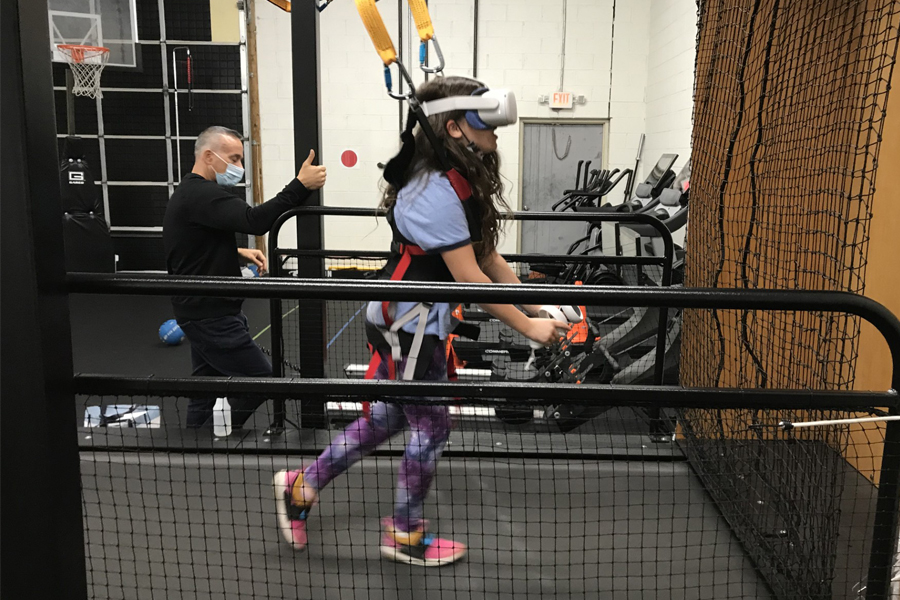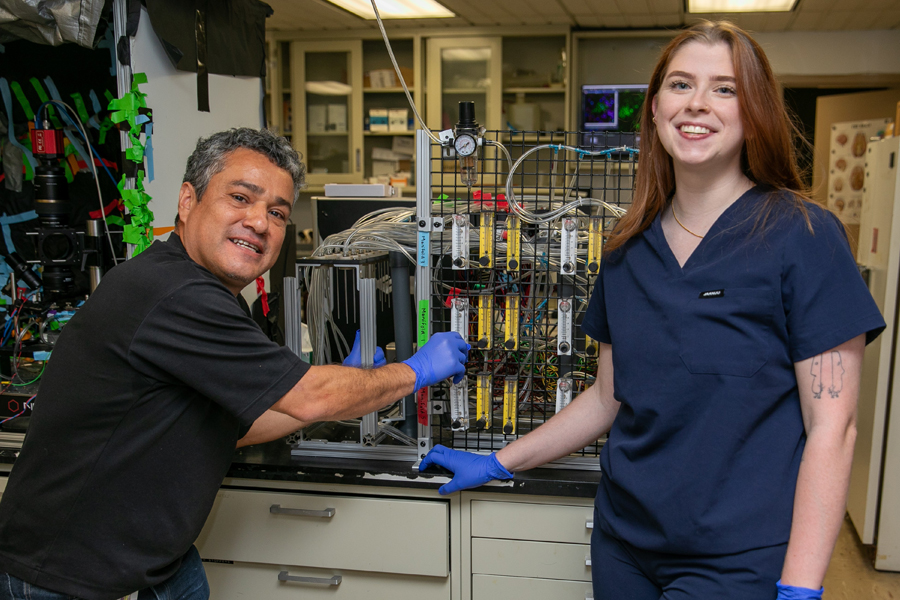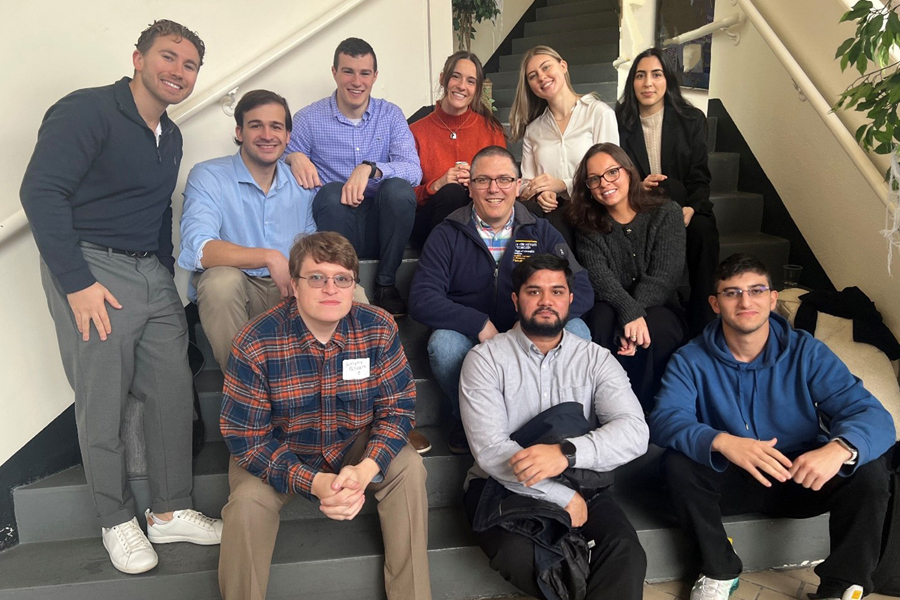Understanding the Cellular Underpinnings of Obesity
Henry Ruiz, Ph.D., clearly remembers peering through the microscope at the strange phenomenon that has become a big focus of his research at New York Tech. Trying to understand what makes adipocytes (or fat cells) grow, Ruiz dialed down the levels of an intriguing new protein—and watched the cells balloon up, full of fat, almost immediately.

“The difference was so striking that, at first, I figured something was wrong. We repeated the experiment several times, and it was always the same,” says Ruiz, who joined New York Tech in the fall of 2024 as an assistant professor of biological and chemical sciences. By tracking this effect—and what reverses it, Ruiz and his lab can interrogate the exact molecular changes that make adipocytes get larger, which could lead to new and improved obesity treatments.
The discovery was the culmination of years of work by Ruiz and his colleagues at New York University (NYU), where he was previously a postdoc and research assistant professor, teasing apart the roles of advanced glycation end products (AGEs), which are present in highly processed foods, and the receptor for AGEs (RAGE), which is present on the surface of adipocytes and many cell types in the body, in obesity and diabetes.
Through studies with lab mice and tissue samples from people with obesity, the team found that high levels of AGEs wreak havoc on glucose metabolism and that RAGE is linked to lipid (fat) accumulation in adipocytes and higher levels of obesity.
However, tweaking the levels of RAGE, or molecules in the pathway that exerts RAGE’s effects, has not been shown to give cells that “ballooned up” look. At least not until Ruiz hit upon a new, little understood protein called zinc finger protein 949 (Zfp949) that was affected by the RAGE pathway. Now Ruiz is eagerly exploring what is happening in the cells with lower or higher levels of Zfp949, and how levels of other proteins change, to identify key players in fat accumulation.
“The obesity field has put so much effort into trying to understand how to cure and treat obesity, but our understanding about what is happening at the cellular level to cause obesity is in its infancy,” Ruiz says. “I think it is the elephant in the room that nobody wants to acknowledge.”
Although GLP-1 medications such as Ozempic are helping many people with obesity lose significant weight, most regain the weight if they stop taking them. Ruiz thinks that getting at the root of how adipocytes accumulate lipids is key to better medications that give longer-term benefits or even a cure.
‘Winding Road’ from Neuroscience to Metabolism
Ruiz says his lab will take a big-picture approach by investigating the molecular players and organ systems involved in diseases—starting with obesity and diabetes. Studying Zfp949 will be a springboard for exploring the roles of other proteins that may have similar or opposing functions.
The big-picture, system-wide approach has been an ongoing theme for Ruiz. He became fascinated with neuroscience and how individual neurons communicate with each other during an undergrad course at Queens College. That led Ruiz to a Ph.D. in neuropsychology, the second half of which he spent doing research at Regeneron Pharmaceuticals on the role of a neurotransmitter on colitis.
“That work gave me this broader perspective to see that I don’t have to focus only on the brain but can also look at how the brain regulates all these other systems in the body,” Ruiz says.
For his first post-doc at Icahn School of Medicine at Mount Sinai, Ruiz ventured into the endocrine system and diabetes. He led a study showing that mice genetically engineered to develop Alzheimer’s disease were more likely to have insulin resistance, which can be a precursor to diabetes. Although diabetes has long been considered a risk factor for developing Alzheimer’s, the finding adds to the evidence that the reverse may also be true: Alzheimer’s can set the stage for diabetes.
Ruiz jokes that, while the “winding road” his career path has taken is not uncommon for scientists, his may encompass an even greater variety of research areas than most. He says that he has always been inquisitive and willing to wander into new territory in search of answers.
Looking ahead, Ruiz plans to incorporate his first research love, neuroscience, into his lab. It turns out that AGEs, which Ruiz studied during his post-doc at NYU, build up in the brains of people with Alzheimer’s. One of Ruiz’s goals is to study whether brain-accumulated AGE causes the brain to develop insulin resistance and lose the ability to metabolize glucose, which could initiate or worsen Alzheimer’s.

Focus on Mentoring
For Ruiz, a major draw to being at New York Tech is mentoring. He credits his mentors at Queens College with helping him set goals and chase them. He thinks the guidance was crucial because he had moved from his native Colombia several years earlier and his relatives were not familiar with U.S. universities.
“Other people had parents or cousins who had already been to college, but my lab mentors were playing that role,” Ruiz says. Now he wants to give back to future generations.
This summer, Ruiz will welcome his first lab member: Marina Moussa, a biology major who plans to attend dental school after she graduates. She knew she wanted to join the lab after taking the pharmacology course that Ruiz taught last fall. “I’ve never enjoyed a class so much,” Moussa says. She was fascinated to learn about active ingredients in drugs and how they work in the body. And as uncomfortable as it was at first, Moussa appreciated that Ruiz would call on each student in the small course every meeting—it helped her stay on top of the material and overcome her fear of saying the wrong answer.
“He cared that we understood the material because he is so passionate about it,” Moussa says.
Moussa is already familiar with many of the techniques in Ruiz’s lab, thanks to the labs that she has done as part of her biology coursework. But, she is looking forward to independent research and seeing how the experiments fit into the broad research goals and help advance the understanding of obesity and diabetes. Moussa will conduct some of the first experiments looking at how modifying levels of Zfp949 in adipocytes affects levels of other proteins.
To do those first experiments, Ruiz is still awaiting some materials. But, as he says, “I cannot just sit idle.” He has already started collaborating with fellow New York Tech faculty, including William Letsou, Ph.D., an assistant professor in his department, to carry out bioinformatic analyses of adipocytes with altered levels of Zfp949. The open, collaborative environment is another big strength of New York Tech, Ruiz says.
Another thing he loves about his new academic home? A nice short commute from his actual home on Long Island. It lets him spend more time with his three young daughters and get an earlier start in the lab each morning.
By Carina Storrs
The obesity field has put so much effort into trying to understand how to cure and treat obesity, but our understanding about what is happening at the cellular level to cause obesity is in its infancy. I think it is the elephant in the room that nobody wants to acknowledge.
—Henry Ruiz, Ph.D.
More News

Study: VR Helps Children With Autism Participate in Exercise and Sports
A new study by researchers from the School of Health Professions and College of Osteopathic Medicine demonstrates how virtual reality (VR) can help children with autism spectrum disorder participate in exercise.

Driven by ‘Why’
Third-year medical student Kassandra Sturm leads the charge on a new study helping to uncover the neurological source affecting the sense of smell in autism spectrum disorder.

Technology Partnership Helps Children With Disfluencies
Former NBA star Michael Kidd-Gilchrist has partnered with the College of Engineering and Computing Sciences’ ETIC to develop a prototype of a technology platform that he hopes will help children who stutter.

Engineering a Cancer Treatment Game Changer
A groundbreaking project co-led by the College of Engineering and Computing Sciences’ Steven Zanganeh, Ph.D., provides the world’s first functional, drug-testable, 3-D-printed human colon model.

Gut Instincts: Solving Microscopic Mysteries
Research by NYITCOM Assistant Professor Vladimir Grubisic, M.D., Ph.D., aims to deliver findings that could pave the way for new treatments benefiting patients with gastrointestinal and neurological diseases.

Edward Guiliano Global Fellows: Culture Across Continents
Under the Edward Guiliano Global Fellowship program, seven students traveled the globe, broadening their perspectives and working on transformational research projects.